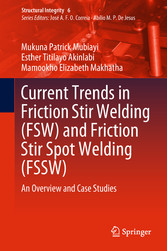Suche
Lesesoftware
Info / Kontakt
Current Trends in Friction Stir Welding (FSW) and Friction Stir Spot Welding (FSSW) - An Overview and Case Studies
von: Mukuna Patrick Mubiayi, Esther Titilayo Akinlabi, Mamookho Elizabeth Makhatha
Springer-Verlag, 2018
ISBN: 9783319927503 , 216 Seiten
Format: PDF, Online Lesen
Kopierschutz: Wasserzeichen




Preis: 96,29 EUR
eBook anfordern 
Mehr zum Inhalt

Current Trends in Friction Stir Welding (FSW) and Friction Stir Spot Welding (FSSW) - An Overview and Case Studies
Foreword
6
Preface
8
Acknowledgements
10
Contents
11
1 General Introduction
14
Abstract
14
1.1 Welding Process Overview
14
1.1.1 Gas Welding
15
1.1.2 Resistance Welding
15
1.1.3 High Energy Density Welding
15
1.1.4 Solid-State Welding
17
1.1.4.1 Friction Stir Welding (FSW)
17
1.1.4.2 Friction Stir Spot Welding (FSSW)
17
1.1.4.3 FSW and FSSW Joint Configurations
20
1.1.4.4 FSW and FSSW Tools
20
1.1.4.5 Tool Material
21
1.1.4.6 Areas of Applications of FSW and FSSW
22
1.1.4.7 Current State of FSW and FSSW Between Aluminium and Copper
23
1.2 Conclusions
25
References
25
2 Friction Stir Welding and Friction Stir Spot Welding of Aluminium/Copper Alloys
30
Abstract
30
2.1 Introduction
30
2.2 Solid State Welding
31
2.3 Metallurgy of the Aluminium-Copper System
31
2.4 Friction Stir Welding
32
2.5 Friction Stir Welding Between Aluminium and Copper
33
2.5.1 Microstructure Evolution and Chemical Properties
33
2.5.2 Mechanical and Electrical Properties
54
2.6 Friction Stir Spot Welding Between Aluminium and Copper
65
2.6.1 Process Parameters
68
2.6.2 Microstructural Evolution
70
2.6.3 Mechanical and Electrical Properties
72
2.7 Conclusions
74
References
75
3 Friction Stir Welding and Friction Stir Spot Welding of Similar Aluminium and Copper Alloys
79
Abstract
79
3.1 Introduction
79
3.2 Friction Stir Welding of Similar Aluminium Alloys
80
3.2.1 The Friction Stir Welding of Similar Aluminium 2xxx Series
80
3.2.2 Friction Stir Welding of Similar Aluminium 5xxx Series
91
3.2.3 Friction Stir Welding of Similar Aluminium 6xxx Series
92
3.2.4 Friction Stir Welding of Similar Aluminium 7xxx Series
97
3.3 Friction Stir Spot Welding of Similar Aluminium
99
3.3.1 Friction Stir Spot Welding of Similar Aluminium 2xxx Series
104
3.3.2 Friction Stir Spot Welding of Similar Aluminium 5xxx Series
107
3.3.3 Friction Stir Spot Welding of Similar Aluminium 6xxx Series
110
3.3.4 Friction Stir Spot Welding of Similar Aluminium 7xxx Series
112
3.4 Friction Stir Welding of Similar Copper
114
3.5 Friction Stir Spot Welding of Similar Copper Alloys
125
3.5.1 Microstructural Evolution and Weld Defects
125
3.5.2 Mechanical Properties
126
3.6 Conclusion
129
References
129
4 Microstructure and Chemical Analysis of Friction Stir Spot Welding Between Aluminium and Copper (Case Study)
134
Abstract
134
4.1 Introduction
134
4.2 Experimental Procedure
135
4.3 Results and Discussion
137
4.3.1 Microstructural Evolution
138
4.3.2 Chemical Analysis
146
4.3.2.1 Energy Dispersive Spectroscopy Analyses (EDS)
150
4.4 Conclusion
162
References
162
5 Microhardness Profile and Shear Tensile Test of FSSWelds AA1060 to C11000 (Case Study)
164
Abstract
164
5.1 Introduction
164
5.2 Materials and Methods
165
5.2.1 Vickers Microhardness Profile
165
5.2.2 Shear Tensile Testing
167
5.3 Results and Discussion
167
5.4 Conclusions
185
References
185
6 Residual Stresses in Friction Stir Spot Welded AA1060 to C11000 Using the X-Ray Diffraction Technique (Case Study)
187
Abstract
187
6.1 Introduction
188
6.2 Materials and Methods
192
6.3 Results and Discussion
194
6.3.1 Effect of Process Parameters on the Formation of a Copper Ring (Hook)
194
6.3.2 Residual Stress Analyses Using the XRD Technique
196
6.3.3 Effect of Process Parameters on the FHWM of the Spot Welds
201
6.3.4 Electrical Resistivity Measurements
202
6.4 Conclusions
208
References
209
Glossary
211




